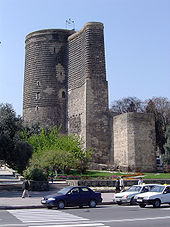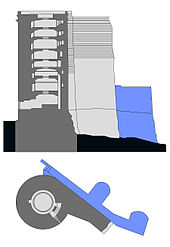Maiden Tower
The Maiden's Tower ( Azerbaijani Qız Qalası ), also known in German as the Maiden's Bastion or Maiden's Tower , is located in the southeastern part of İçəri Şəhər (Itschäri Schähär), the old town of the Azerbaijani capital Baku , which is still partially walled today . It is presumably part of the earlier city fortifications, the eastern section of which, to which the 29.5 meter high tower belonged, no longer exists. The tower is like the entire historical city center and the Palace of the Shirvanshahs since 2000 by the UNESCO as worthy of protection World Heritage classified.
Location
The Maiden's Tower is located near the Caspian Sea , in the southeast of Baku's old town on a curve in Neftjanik Prospect ("Oil Workers' Alley": Neftçilər Prospekti or Проспект Нефтяников), a major road in Baku along the Caspian Sea coast.
history
The age of the Maiden Tower cannot be clearly determined. There are conflicting opinions on this. There are assumptions that the foundations date from the 5th or 6th century and the upper parts were made in the 12th century. This is indicated by an inscription by Mesud ibn Da'ud on the outside of the tower on the occasion of a reconstruction. That at that time only the upper part was rebuilt, it is concluded that the inscription is not above the entrance to the tower, but in a side area at a height of 14 meters.
The roof of the tower was the only part that was often rebuilt, as the cannons were housed here. The building was renovated at the beginning of the 20th century.
Components
The Maiden Tower is made from local limestone. It is cylindrical and has a height of 29.5 meters with a diameter of about 17 meters. The wall thickness is five meters at the bottom and decreases to four meters at the top. Inside, the tower has eight floors, which are spanned by stone vaults. Each vault has an opaion three meters in diameter in the middle . These enable the chambers to be illuminated and ventilated. There is a low room on each floor. The floors are connected by a staircase in the wall. The ground floor can only be reached by a ladder that used to be pulled up in case of danger. Inside the tower there was a 21 meter deep well that ensured the supply of groundwater. There are several man-high openings on each floor, some of which show the rising sun on midsummer days. They are hardly suitable as loopholes. From a height of about 14 meters, jewelry is notched in the outer walls. The entire tower is traversed in the masonry by a vertical tube made of nested conical clay tubes, which feeds speculations about its former function. The theories on this are diverse and range from use as a lighthouse, as a sun or fire temple to use as a defense system.
An opening on the fifth floor leads directly to the outside; it used to be closed with a door. The opening and the corridor are badly worn. At this point on the floor there are remains of vaults and consoles, from which it can be concluded that a porch used to be attached here. On this side there is also a short wall with two bastions that are about half the height of the tower. They are massive and do not accommodate any rooms. They are popularly called breakwaters in Azerbaijan , but their actual function is controversial. However, it is possible that the water level of the Caspian Sea used to reach the tower. The legend fits the name of the building: a princess is said to have thrown herself from the tower into the sea in order to avoid a marriage arranged by her father with a partner she did not want or even with himself.
The architectural style of the Maiden Tower has not yet been clearly assigned to any known architectural style. Its massive construction corresponds neither to the Turkish nor to the Persian architecture. This is why researchers have been puzzling for decades what the legendary landmark of the Azerbaijani capital Baku might have been used for.
literature
- Ilona Turánsky, Károly Gink: Azerbaijan - palaces, towers, mosques . Corvina, Budapest 1980 (German by Tilda and Paul Alpári).
- Ilona Turánsky, Károly Gink: Azerbaijan. Palaces, towers, mosques . Dausien Werner Verlag, 1997, ISBN 3-7684-1955-X .
Web links
Individual evidence
- ↑ UNESCO World Heritage Center: Walled City of Baku with the Shirvanshah's Palace and Maiden Tower. Retrieved August 25, 2017 .
- ↑ The mystery of the Maiden Tower is to be solved. In: ORF ON Science. Retrieved December 1, 2017 .
- ↑ Mythical building, illuminated with laser (Vienna University of Technology) , [ Mystery of the Jungfrauenturm is to be solved. In: ORF ON Science. Retrieved December 1, 2017 . ], [1] , [2] , [3] , [4]
- ↑ Mythical building, illuminated with laser In March 2009, a research team from the Vienna University of Technology tried to uncover the secrets of the Jungfrau Tower using 3D measurement methods.
Coordinates: 40 ° 21 '58.2 " N , 49 ° 50' 14.1" E


